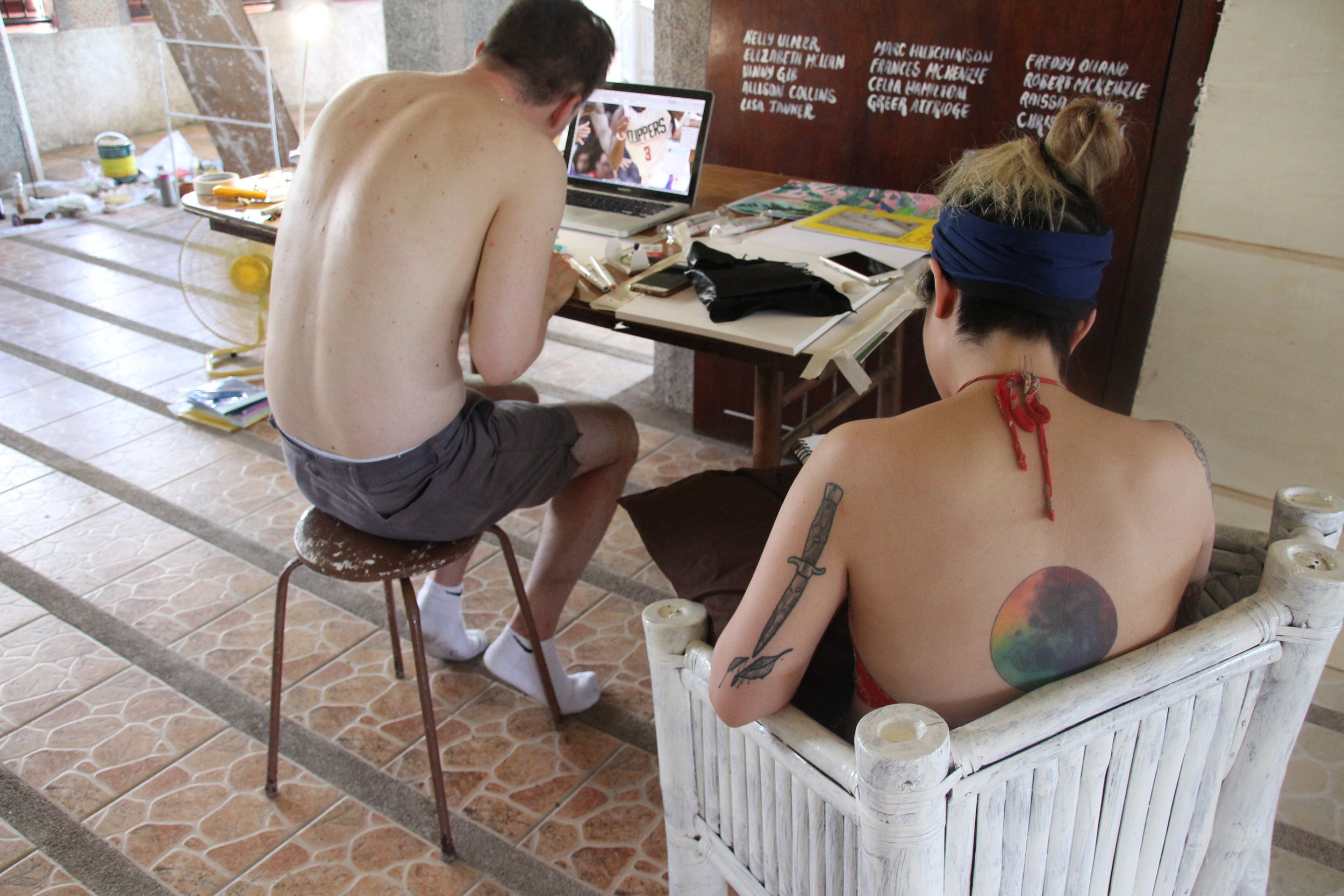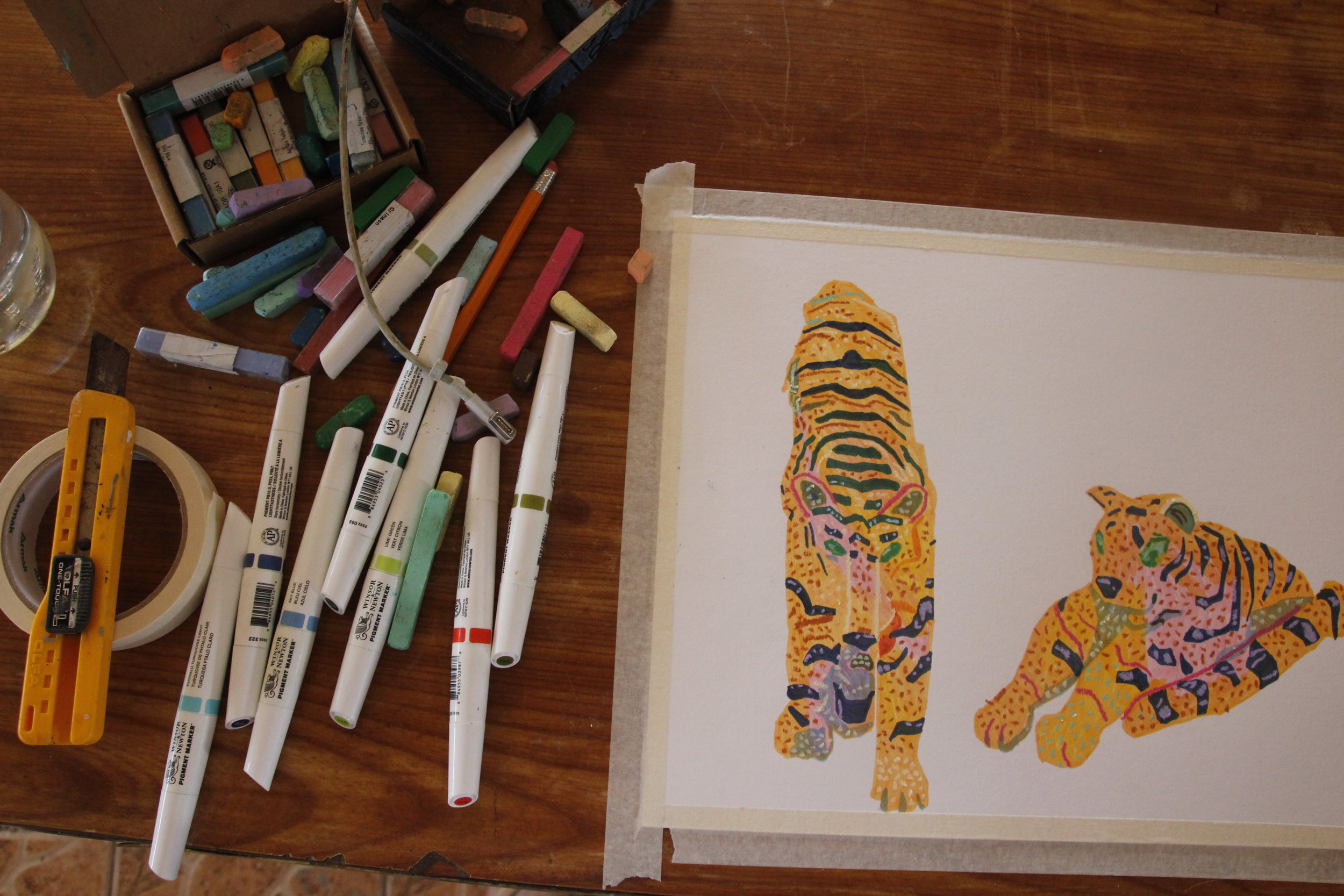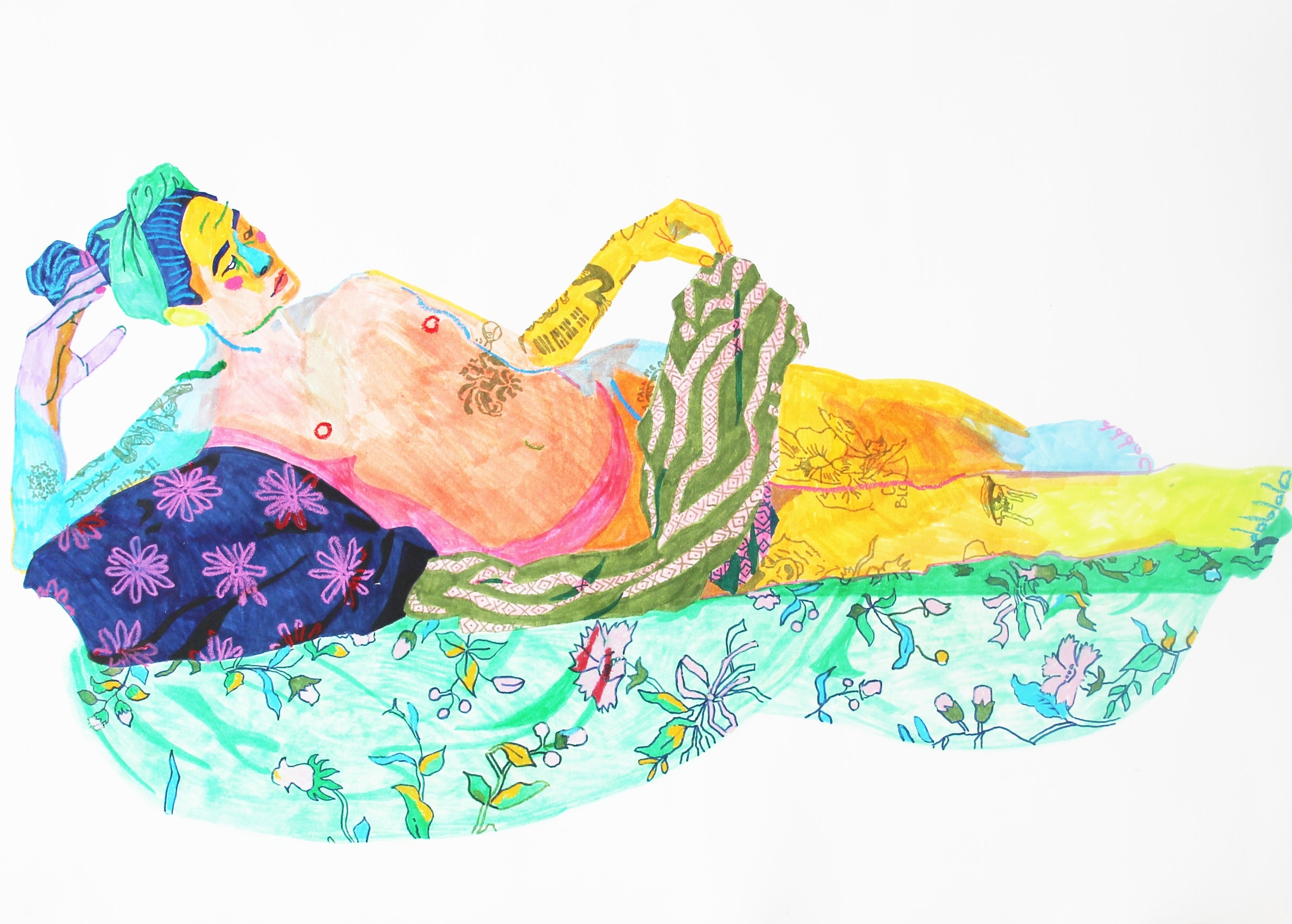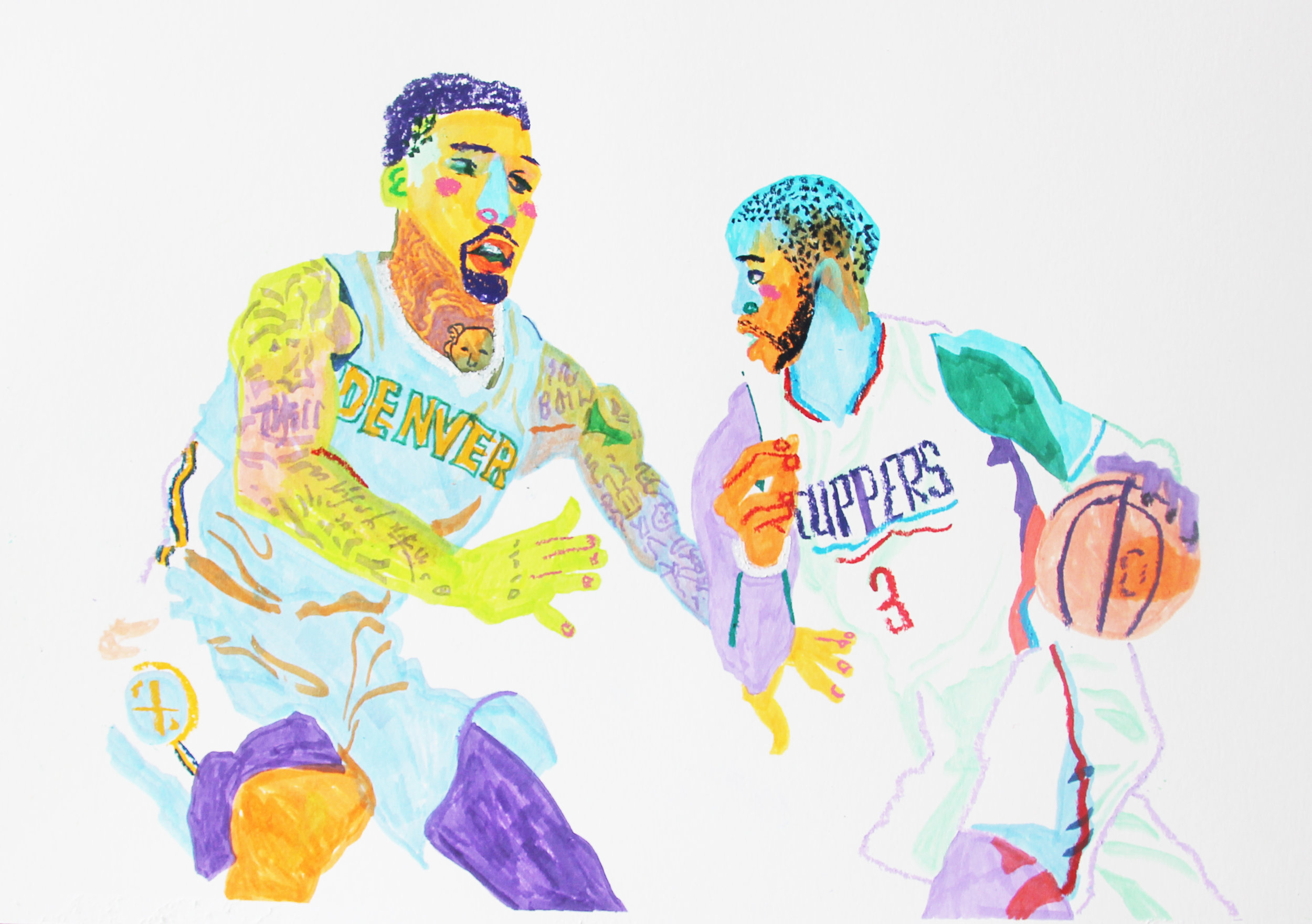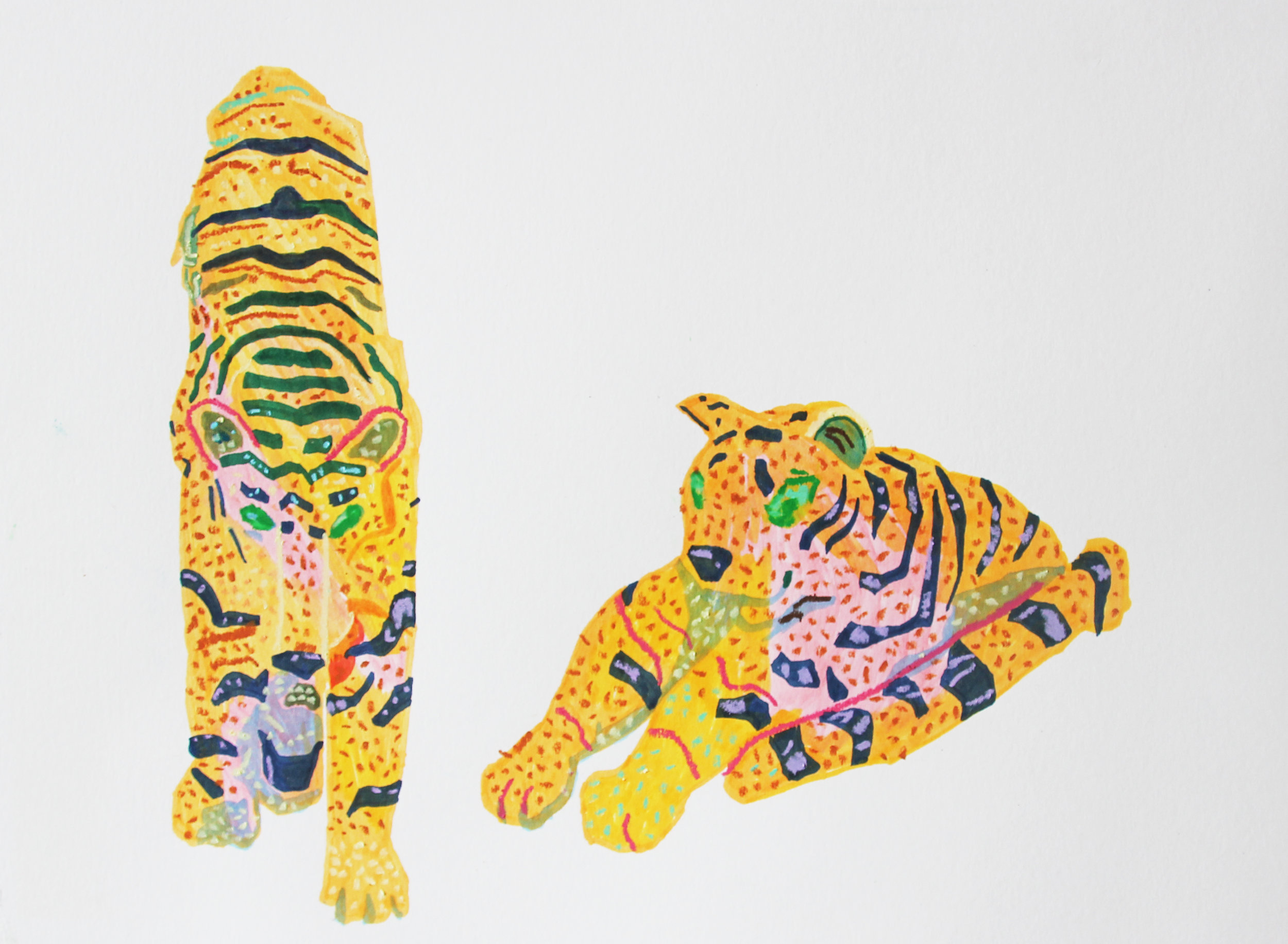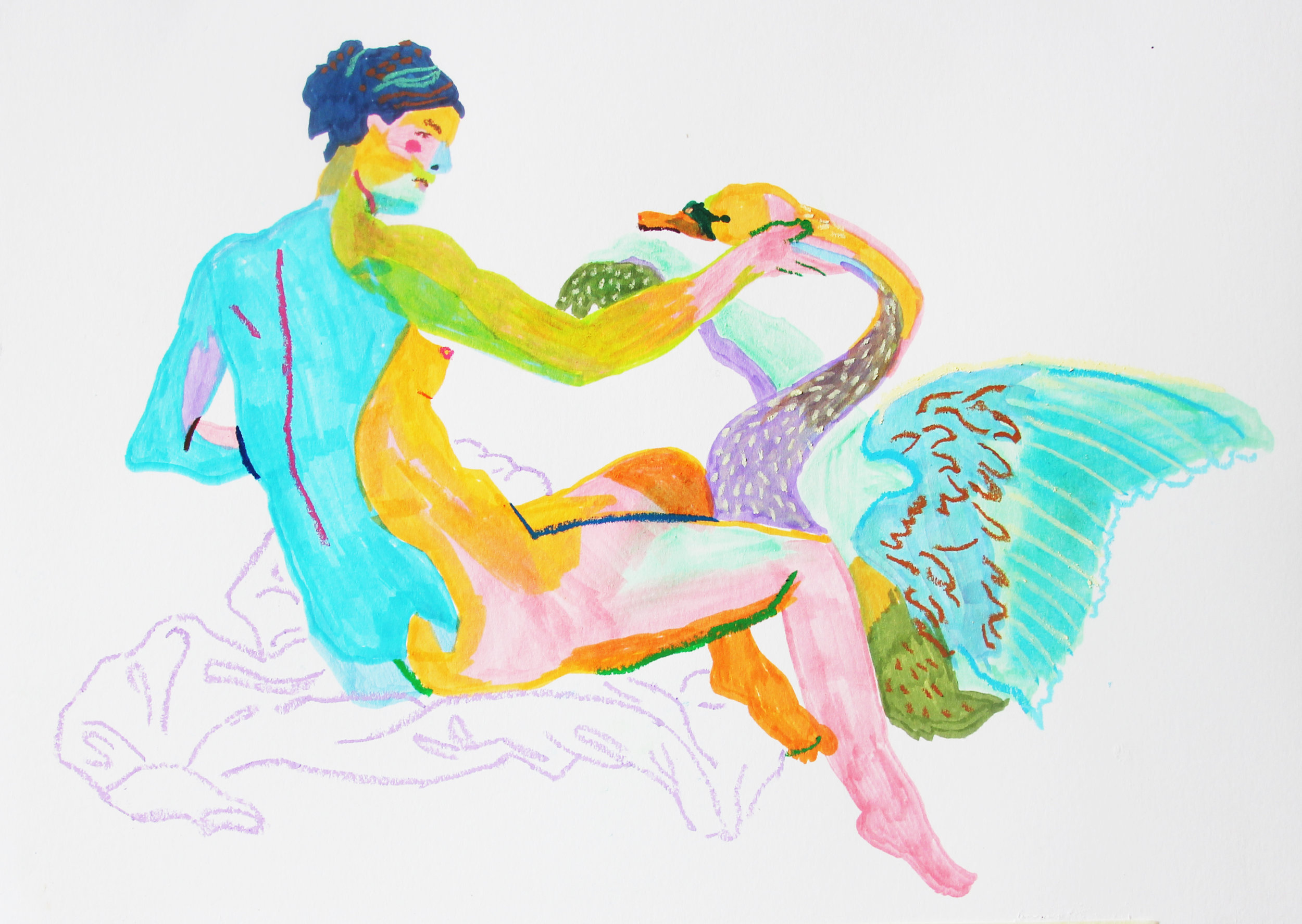Andy Dixon Re-defines Opulence in the Wet Market
Painter
Vancouver, BC
May 2017
It’s hard to write an introduction about Andy Dixon and his work without repeating something already written. Within the last decade, Andy’s work has gained recognition and a following few artists can replicate. Quick search will produce a dozen articles. His commercial success underscores the potential for contemporary art to prosper within mainstream culture.
Andy’s paintings speak of the opulent lifestyle of the extremely affluent. He taps into the plethora of images and symbols from the current cultural lexicon, and presents it back in another medium. To purchase Andy’s work is to take part in the performance about the market of wealth, furthering the layered narrative of his work.
Batan Still Life
Due to the limitations of time, shipping and lack of art supply stores in the area, Andy planned to create new works on paper. With paint markers from Vancouver, Andy developed an image in classic vanitas still life. Composed of artfully arranged produce and meat from the market, as well as objects gathered from in and around the studio, Andy created a piece that succinctly embodies the values and essence of Batan. Though seemingly modest, the grouping of fish, squash, bananas, papaya and various other produce, is wealth as it means to the people of this town. It was a departure from his standard format of large scale acrylics on unstreched canvas. The medium presented an immediacy that worked well with the conditions of the project. Andy dedicated his time at the residency to conceiving and making the work that would be silk screened by a small print shop in Kalibo after his departure.
Market Day
Going to the local market for meat and produce is a daily ritual that begins early in the morning. The trip to the market is an act with extreme significance. This care is reflected in Andy’s still life, as well as the ritual in sourcing each item. The produce and meat was carefully selected by Andy during one rainy day. After the still life was staged and documented, the bounty was served to the rest of the artists in residence. A successful trip to the market implies that the meals will be fresh and abundant as the family partakes of it together throughout the weeks
To the inexperienced, the rows of vendors seem to offer almost identical goods - yam leaves, string beans, eggplants, papayas, bananas, potatoes, carrots, onions, mangoes, as well as seasonal produce that pop up from time to time. But the seasoned buyer is sensitive to subtleties and understand there are details to consider in choosing what you buy and who to buy it from. Did the mangoes come from Davao or Iloilo or Kalibo? Do you trust the vendor in their claim of outstanding taste and freshness? The time and care dedicated to shopping for food lays the foundation for the rest of the day. Going to the market is an act of service to the family, as well as a social time to gather bits of news and information about local happenings. Unlike big cities like Manila that have long since established trade within different parts of the country and has been infiltrated by western culture thoroughly, Batan still remains relatively unchanged.
The environment you usually do research and acquire imagery was certainly different here in Batan. From stately lords, ornate ballrooms and luxury brand names, what was it like to orchestrate imagery here in a small fishing village?
Batan was a welcomed distance from the world in which I make my work about - the art market. My work can be seen mostly as a self-criticism about coming to terms with my participation in such a strange and often cruel market and I see my time in Batan as a moment to step back a bit to see the bigger picture, not unlike when we take a physical step back from a painting to see the whole thing.
Can you share with us your experience of purchasing fruits and other tropical ingredients in the wet market?
I went to the market in Batan one day solely to buy fruit for aesthetic purposes. I browsed the stalls looking for fruit that was unique to the area as well as beautiful in order to stage a still life akin to a Flemish master painting.
In those old Flemish still lifes, the fruit depicted were symbols of human accomplishment and wealth. The oranges and papayas had travelled great distances to get to their country so they were very expensive objects of luxury. So when I bought essentially the exact same varieties of fruit but for mere pennies and from a place they are native to, the context changes but the visuals stay the same.
You had a show at Winsor Gallery in Vancouver aptly titled “Expensive Things.” It had themes of decadence and patronage. In Elliat Albrecht’s words, “your work depicted familiar tokens of abundance: fine violins, exotic fruit, lush nudes and distinguished wooden ships, riffing on the kind of banal imagery that typically adorns the walls of the moneyed.” There’s obviously a contrast with the work you’ve done here in Batan. The concepts of wealth and abundance is still explored but it seems to be flipped on its head. Creating a banquet scene out of staple Filipino ingredients fresh from the market or an image of a reclining nude draped with local linens must have brought a different side to the usual themes you explore. What was it like to paint provincial signifiers of wealth within a developing country?
Yeah, it was a bit turned on its head and yet I think the final result ended up looking very similar. In those old Flemish still lifes, the fruit depicted were symbols of human accomplishment and wealth. The oranges and papayas had travelled great distances to get to their country so they were very expensive objects of luxury. So when I bought essentially the exact same varieties of fruit but for mere pennies and from a place they are native to, the context changes but the visuals stay the same.
Were you aware of these themes before arriving at the Residency? Being a painter that questions these concepts, what do you think are the differences and are there any common grounds?
Again, my work isn't necessarily about class or wealth in general - it's an exploration of the meta idea that a painting of something luxurious becomes a luxury object itself. In a cheeky sort of way, I'm comparing my work to the objects I paint. I wasn't expecting to find these kinds of concepts in Batan so I saw it more as an unbiased or unrelated free space to think about things more clearly.
Maybe making things difficult and helping are the same thing in this case. Meaning the challenges I faced with materials, temperatures, etc were the things that offered help in a bigger picture sense.
Compared to your large scale paintings, did you have an audience in mind as you made work here? Or was your work while here more of a reset or even research?
Yeah, I saw it a bit more as research. I've never really taken the time to explore working on paper and have wanted to for some time. It's hard for me to find the time to try things that I know won't be successful right away considering the demand for my canvases. It was nice to get away and concentrate on something new.
The heat, the pace of this place, one’s access to resources are very different here compared to New York, Vancouver and Los Angeles. How did this place affect your work? What helped and what made things difficult?
Maybe making things difficult and helping are the same thing in this case. Meaning the challenges I faced with materials, temperatures, etc were the things that offered help in a bigger picture sense. It's nice to know that in a place like Batan, with limited access to art supplies, I'm still able to express myself using, say, a pencil and a piece of beautiful handmade wrapping paper.
You had to explore other mediums while you were here. You chose to work with paint markers and oil pastels on paper while working on a table surface rather than the floor. Even the scale of your piece was different. Was this short switch in production insightful? Did it reveal anything about your usual practice?
I decided that I wanted to practice my line work while I was at Elmo's House. It had been too long since I attempted to sit down a sheet of paper and draw and I found that practicing my rendering on a smaller scale was very helpful.
What were some of your favourite moments while here? Can you share some of these experiences with us?
I had the pleasure of being at Elmo's House during what I believe to be the busiest or most attended moment of the residency and I liked that. I really enjoyed the meals - sitting around the table, discussing art, culture, and life with many other creative people from all areas of the globe was a treat for me. I love people and get great enjoyment from hearing about other people's points of view.
Elmo’s House Artist Residency's place within this community is complicated and is still in the process of being defined. The effort to become part of an international arts community is ongoing, along with the work to build our foundation locally.
To bring artists to the centre of this place, as observers and students of life, to draw inspiration, to exercise critical thinking, to question tradition as well as to take part in it, is a privilege. Elmo’s House allows artists to move through spaces between innovation and long standing customs, between cultures and belief systems. The distance between can feel vast, but artists are great connectors.
From flemish paintings to the Batan wet market, Andy Dixon found a path, pointing to the history of trade, discrepancy in value and the inequity of distribution. Though this connection is not new, it is a poignant observation from a perspective specific to the experience Elmo's House provides.
Learn more about Andy Dixon
andydixon.net






